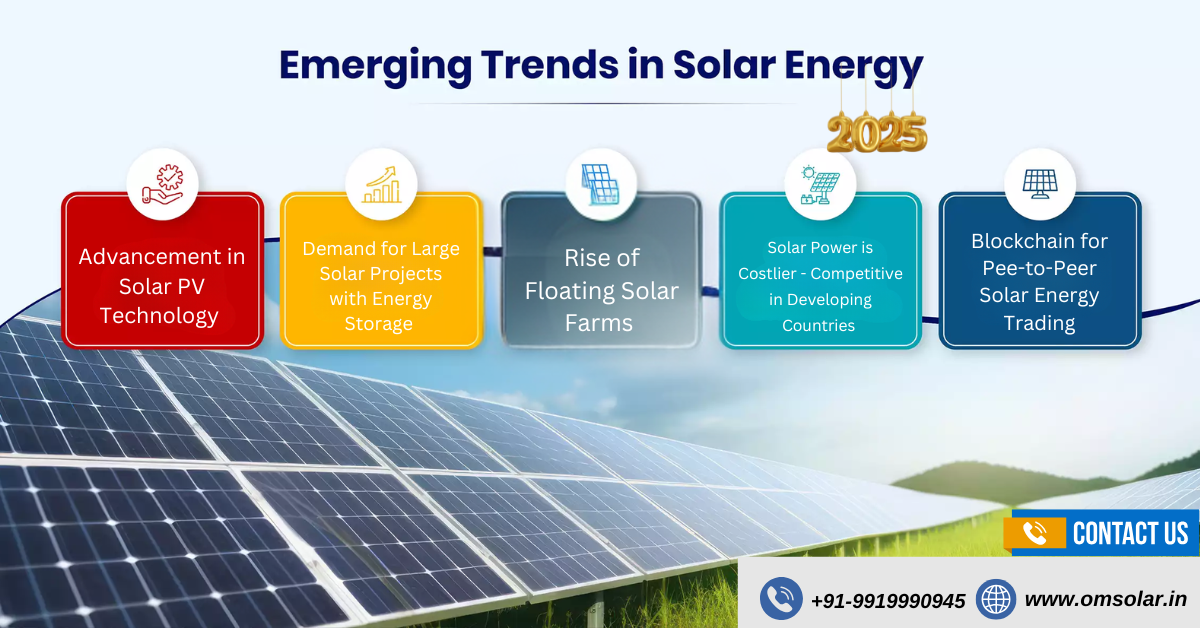Based on the US Solar Market Insights 2023 Year in Review by Solar Energy Industries Association (SEIA) and Wood Mackenzie, Solar accounted for 53% of new electric generating capacity added to the grid. Moreover, it was noted that in 80 years, renewable electricity sources accounted for more than 50% of annual capacity additions.
The research and studies prove solar energy ( the renewable electricity source ) is taking over electricity generation, rapidly revolutionizing the industry.
In this blog, we will share the emerging Solar Energy Trends in India for 2025, which are highly considerable.Â
Read More: 1 MW Solar Power Plants: Price, Specifications, And Complete Guide For Om Solar Solution
Advancement in Solar PV TechnologyÂ
With India’s rapid advancements in technology, the solar PV market is significantly improving efficiency and reducing costs. The perovskite solar cells and bifacial panels are very promising innovations, which is higher energy yields and are adaptable to diverse environments. However, the new coating technologies and lightweight materials are enhancing the usability of PV systems, especially rooftop installations. The government’s push towards Indigenous manufacturing under the “Make in India†initiative is improving research and & development. Moreover, the advancements become more commercially viable, making the solar industry much more promising for India; ‘s greener and more independent future.
Demand for Large Solar Projects with Energy StorageÂ
The integration of energy storage with large-scale solar projects is a game-changer for the solar energy sector. With increasing grid instability due to variable renewable energy sources, battery storage solutions ensure a steady power supply. India is investing heavily in utility-scale storage systems, such as lithium-ion and flow batteries, to complement solar power generation. These systems allow surplus energy to be stored and utilized during peak demand or low sunlight hours. This trend aligns with India’s renewable energy goals, promising enhanced grid reliability, reduced dependency on fossil fuels, and accelerated decarbonization of the power sector.
Rise of Floating Solar FarmsÂ
The ‘Floating Solar Farms’ are innovative solutions to land constraints, that leverage water bodies for solar power generation. These solar installations will help reduce water evaporation, utilize underused reservations, and minimize ecological disruptions. India has even begun investigating floating solar projects in states such as Kerala and Maharashtra, both of which have abundant water. Floating solar farms are also less prone to overheating, which reduces the heat-induced degradation of snails’ efficiency from traditional land-based systems. The trend opens up huge possibilities for India, which has been eyeing achieving its ambitious solar energy targets ecologically and in a space-saving fashion.
Solar Power is Costlier – Competitive in Developing CountriesÂ
Declining equipment costs and the rising number of innovative financing models have made solar power more cost-effective in India as it becomes increasingly competitive. Type of Power: Solar Tariffs in India are some of the lowest globally which makes it one of the most attractive & cost-effective generation. The adoption of industries and households is being promoted by government incentives such as subsidies, and tax benefits. Nevertheless, hurdles remain as the initial investment is quite large and the import dependence of components Nevertheless, India’s initiatives to MADE in India and localizing manufacturing along with streamlining the supply chain are making solar power is viable & sustainable choice for the future.
Read More: Top 10 Solar PV Module Manufacturers in India 2024: Leading Brands, Prices, and Installation
Blockchain for Pee-to-Peer Solar Energy Trading
By trading energy while it is being made — a service known as peer-to-peer (P2P) transactions that blockchain technology makes possible. This decentralized model enables households and small businesses to sell excess energy directly to consumers, resulting in the exclusion of numerous traditional utility companies. Using blockchain Virtually as old as time itself, pilot projects in India are investigating the use of a blockchain-based trading platform to help expand access and transparency around energy. Real-time energy tracking is possible thanks to the technology, optimizing resource utilization as a result. The adoption of blockchain can empower communities, reduce transmission losses, and enable a more robust energy market for India.
Smart Inverters Revolutionize Solar Energy StorageÂ
Smart inverters change the game for energy storage adding efficiency and resiliency Through this process, advanced inverters optimize the flow of electricity between solar panels, batteries, and the grid to provide an amazing amount of control for energy management. It also improves the system stability by regulating voltage and frequency variations. India, Smart inverters are gaining adoption in the country backed by a rise in consumer awareness and affordability. The use of such devices is also key for off-grid applications, as they are a way for rural areas can enjoy regular power. The introduction of these smart inverters can speed up the pace at which India moves towards a renewable energy-focused economy.
AI Shapes the Solar Energy IndustryÂ

Fortunately, companies like Oxford PV are hoping to change this with the help of artificial intelligence (AI). Using this data, predictive maintenance is provided by AI-driven algorithms allowing solar installation to maintain their highest output possible. Moreover, they incorporate lots of AI skills for weather and energy usage data processing in order to predict the supply level reliably. AI being employed to create Smarter Solar Grids in India Load Balancing Now a Breeze, System Resilience Enhanced This technology has helped solar energy operators to lower costs and improve monitoring of different aspects. This is where introducing AI can help the solar energy industry in India unlock new efficiencies and build on innovation as adoption grows.
Batteries Become More Cost-Effective
What has also facilitated the Expansion of solar technology in India are deflating costs of batteries, notably lithium-ion and solid-state technologies. Breakthroughs in battery chemistry and manufacturing are driving down the cost of energy storage. For India, where intermittent solar power generation needs energy storage solutions this kind of innovation is crucial. Enhanced energy efficiency and extended life-span of batteries are additional features contributing to their popularity among residential, as well as commercial users. With the proliferation of increasingly affordable batteries, these new types will be critical enablers that help India shift towards a renewable energy-centered economy.

Role of Agri Voltaics in India’s Solar Revolution
Agrivoltaics, a way of sharing land between solar power and farming, is growing in popularity as an ancillary solution to address the issues with land use. With this method, we facilitate the generation of energy with low C as well as agricultural production by installing solar panels on crops.
Being a place where land is the problem, in India, Agrivoltaics holds extensive ground to boost up scalability of production without disturbing agricultural activities. Studies have also shown that certain crops grow well and retain water more effectively when grown under the partial shade offered by raised solar panels while enjoying protection from heat stress at the same time. With India on a path of continued population and energy demand increase, agrivoltaics stand to allow for rural livelihoods in the backdrop coupled with national renewable energy targets.
Read More: Om Solar Solution: Success Stories Of A Leading Solar Company In Haryana
2025 Likely Being Much Revolutionized Year for Solar Energy
A turning point is due in 2025 for the country’s solar energy sector, with Advances expected in technology, policy, and infrastructure. Live floating solar systems, energy storage, or AI-operated systems are going to transform the energy landscape. Popular initiatives from the Government of India, including the recently launched National Solar Mission and other ambitious targets, represent a strong impetus for this growth. As India continues to take precedence in the deployment of solar energy, 2025 will mark a significant leap towards realizing this goal of the country: to become a national powerhouse of renewable energy in the world.Â
Contact Us
Brand Name: Om Solar
Call/WhatsApp: +91-9919990945
Email: sales@omsolar.in
Website: www.omsolar.in

